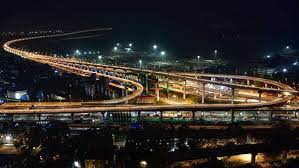
Atal Setu
Atal Setu
GS-3: Economy and Infrastructure
(UPSC/State PSC)
Important for Prelims
Atal Setu, Mumbai Trans Harbour Link (MTHL), Budget outlay.
Important for Mains
Features of Atal Setu, Technologies Incorporated, Concerns related to Atal Setu, Benefits, Conclusion.
Jan. 18, 2024
Why in News:
Recently, Prime Minister Narendra Modi inaugurated the Atal Bihari Vajpayee Sewri-Nhava Sheva Atal Setu in Maharashtra.
About Atal Setu:
- Atal Setu in Maharashtra is also known Mumbai Trans Harbour Link (MTHL).
- This sea bridge was inaugurated on January 12, 2024.
- The foundation stone of the bridge was laid by the prime minister in December 2016.
- Budget outlay: This bridge has been built at a cost of approximately ₹17,840 Crore.
Features of Atal Setu:
- It is the longest bridge and also the longest sea bridge in India. It is the 12th longest sea bridge in the world.
- It is a 21.8-km long six-lane bridge having 16.5 km length over the sea and about 5.5 km on the land.
- Potential: It is expected to ferry almost 70,000 vehicles daily on completion and have a life of 100 years.
- The saving in fuel cost would be around ₹500 per journey.
- Toll: The Maharashtra government has cleared a proposal to charge ₹250 as a one-way toll for cars on the Setu.
- Only half the amount, as per existing rules of toll collection is being charged.
Technologies Incorporated:
- It is fitted with technology to oversee a smooth commute, including an Intelligent Traffic Management system, Video Incident Detection system, Speed Enforcement system, emergency call boxes etc.
- MTHL incorporates various innovative technologies, such as Reverse Circulation Drilling (RCD) piling, Orthotropic Steel Deck (OSD) bridge girders, and Open Road Tolling (ORT) system.
- RCD is used for the first time in India, an innovative technology employed for pile foundation laying, it minimizes noise disturbances compared to the traditional vertical drilling method.
- OSD is a construction method that combines strength and flexibility. This technology allows the bridge's steel deck to withstand heavy loads, such as vehicles, while maintaining a lightweight structure.
- It is the country's first project to adopt the ORT method of collecting tolls without requiring vehicles to stop or slow down.
Benefits:
- Faster Connectivity: It will provide faster connectivity to Mumbai International Airport and Navi Mumbai International Airport.
- All Weather Technology: It has specially-designed lighting poles to withstand high-velocity winds during monsoons and is also equipped with a Lightning Protection System to safeguard against potential damage caused by lightning.
- Environmental Sustainability: From Sewri, an 8.5-km noise barrier has been installed since the portion of the bridge passes through a flamingo protected area and Bhabha Atomic Research Centre.
- Commuter Aid: It will reduce the travel time from Mumbai to Pune, Goa and South India.
- The bridge has been constructed with corrosion-resistant material that promises to stand firm against earthquakes, cyclones, high wind pressures and tides.
- The project is expected to facilitate greater economic integration of Navi Mumbai with Mumbai, with benefits extending to Panvel, Alibaug, Pune, and Goa.
- The bridge has shortened the distance between Mumbai and Navi Mumbai to just 20 minutes which earlier took 2 hours.
Concerns related to Atal Setu:
- Impact on Fishing Community: Implementation of the project poses significant challenges to local livelihoods, especially the fishing community.
- Disruption of fishing grounds: Construction activities disrupt fish breeding grounds and migration routes, which actually affects the overall fish population.
- Disadvantages of access: Traditional fishing areas may become inaccessible, forcing fishermen to travel long distances or resort to less productive fishing areas.
- Damage to fishing practices: Increasing boat traffic and construction activities threaten to damage fishing practices, which greatly impacts the sustainability of fishing practices.
- Environmental Concerns: The construction and existence of the bridge raises environmental issues that need to be carefully considered.
- Habitat destruction: Important ecosystems such as mangroves and coral reefs face destruction, which negatively impacts the biodiversity needed for fish populations.
- Pollution risks: Dredging and construction activities pose pollution risks, potentially harming marine life and compromising water quality.
- Changes in coastal processes: The presence of bridges can alter natural coastal processes, leading to shoreline erosion and loss.
Conclusion:
Atal Setu is an important step in terms of urban planning. The rapid concretisation and infrastructuring of the city with roads, highways and tunnels in recent years, however, has created several environmental problems.
Source: Indian Express
----------------------------------------
Mains Question
Express your views on the relevance of Atal Setu in the urban social and ecological context of the 21st century.